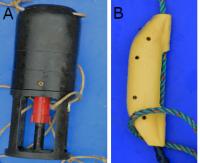Methods
The pinger deterrent effect on harbour porpoises

Eight continous porpoise detectors, or C-PODs, were deployed in the waters off Kullaberg nature reserve, north of Helsingborg, on the west coast of Sweden. A C-POD records sounds between 20-160 kHz omni-directionally, distinguishing ultrasonic click trains by echolocating odontocetes from other sounds in the ocean, such as boat echo sounders. It can detect a harbour porpoise at a maximum of ca 400 m.
The C-PODs were placed peripendicular to the coast line 0, 100 and 400 m from the pinger in pairs (see picture below). The Banana pinger (B) was tested first, from October to December, and the Seal-safe pinger (A) last, from December to February. Both pingers were set on a 30 hour ON/OFF cycle, were the OFF period worked as the control.
Due to technical issues with the Seal-safe pinger its data was lost and could thus not be included in the study.
For the Banana pinger the number of detection positive minutes per hour (DPM/h) in each position was counted. This means the number of minutes during an hour that the C-POD was recording harbour porpoise clicks. This was then used as the dependent variable in the statistical analysis.

Responsible for this page:
Director of undergraduate studies Biology
Last updated:
06/01/18
